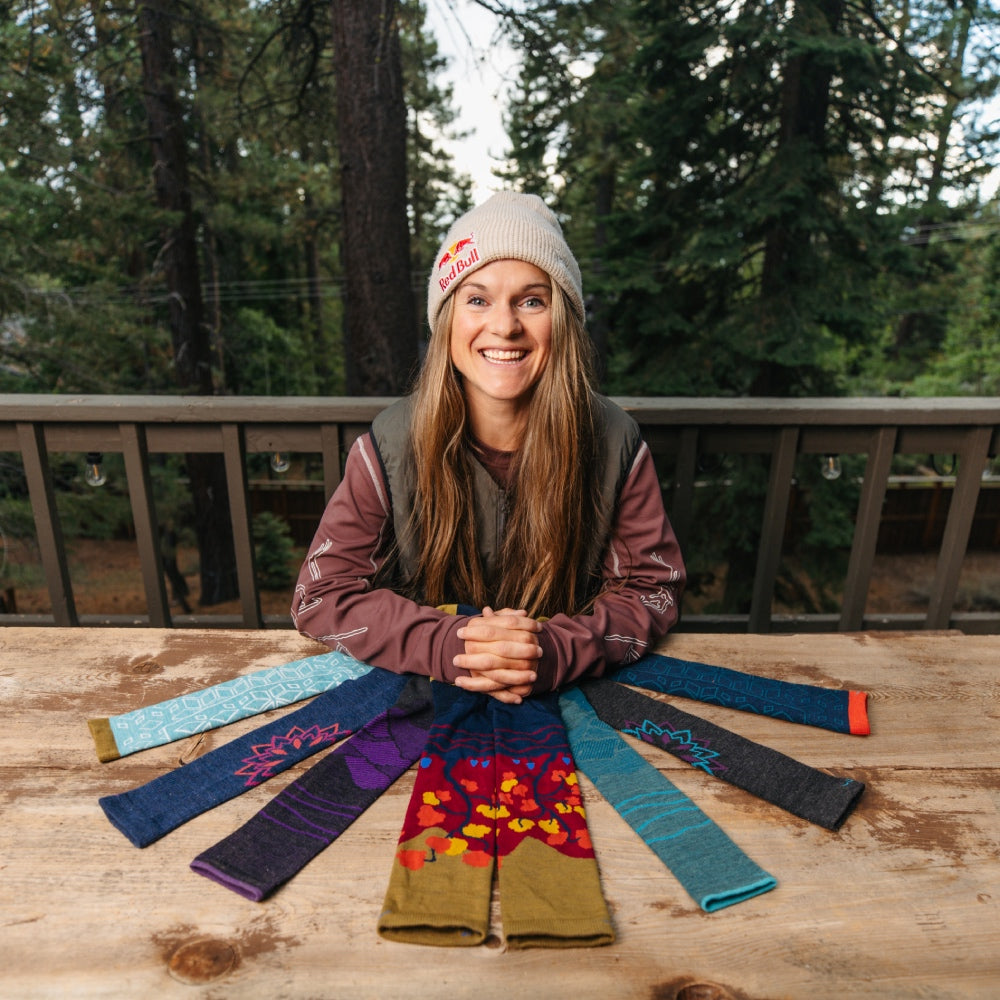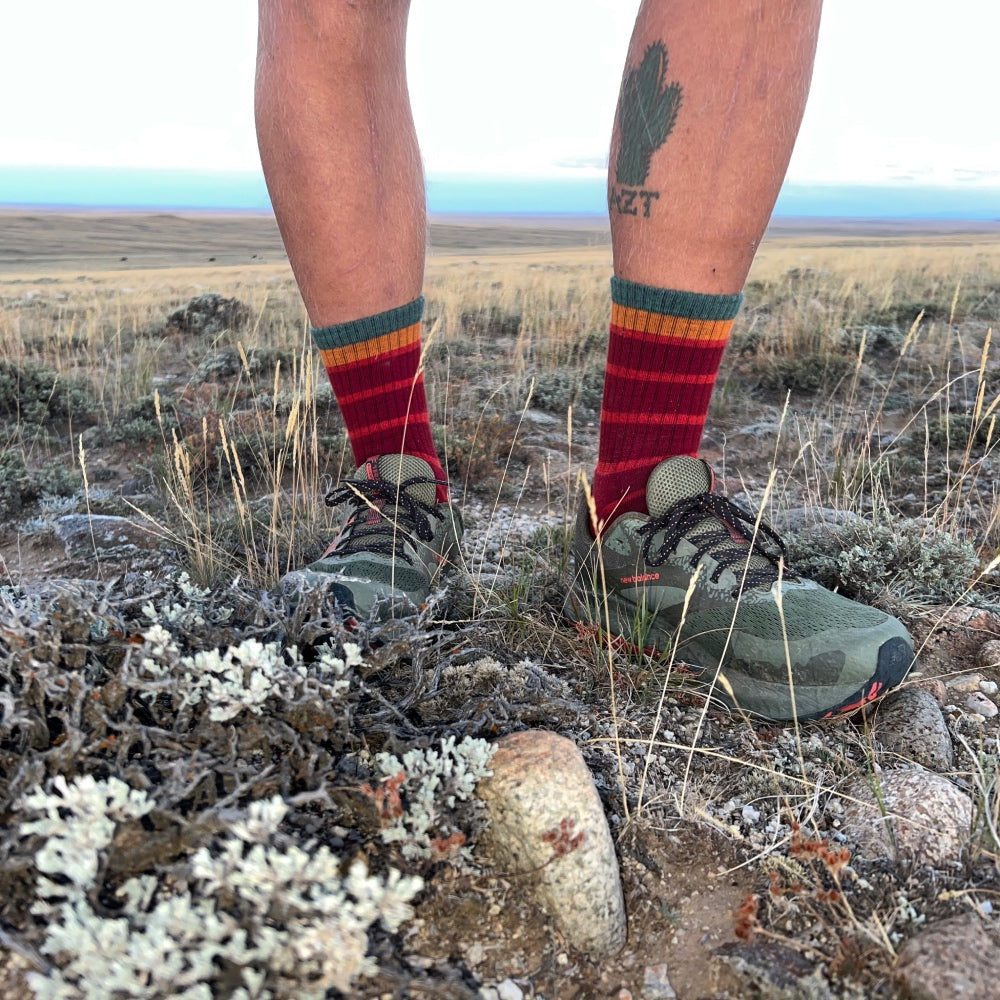5-ish Reasons You’ll Love Merino Wool Socks for Winter

Here in Vermont, home of Darn Tough socks (yup they are still knit 100% at our two VT mills), Mt. Mansfield recently logged sub-freezing summit temps and NH’s Mt. Washington reported their first snow of the season!
Winter is coming and if you live in the northern hemisphere that probably comes as no surprise. And after keeping your feet cool and fresh all summer, Merino Wool socks are still going to be your warmest socks and the best socks for winter. Let’s celebrate 5-ish reasons why Merino Wool makes the best warm winter socks.

1a. Merino Wool is a relentless insulator…
Merino Wool winter socks offer insulation that keeps feet warm in cold weather. Merino fibers have a complex structure with microscopic crimps and bends that trap warm air. When you wear wool base layers during winter activities, you can harness the heat of exertion to create a cozy microclimate that protects your body temperature.
Humans can lose heat easily in cold weather; we radiate heat into the air, breathe it out, and lose it through contact with surfaces. So, if you’re planning to get out there in the cold and snow, whether for a gentle walk or a backcountry tour, make sure to have soft, insulating Merino Wool base layers as your first line of defense in staying warm and protected against winter’s chill.

🧦 Merino musing: If you’re on the fence about what sock weight and cushion option to choose, just remember that more merino fibers = more merino benefits. For the warmest Merino Wool socks choose a pair from the Darn Tough Heavyweight collection - bonus points if you go for Full Cushion! Heavyweight + Full Cushion = warm, thick socks for winter (Well, the thickest we knit. More on that in Reason #3).
1b. …even when wet

Ideally, our clothing stays dry while we’re playing outside in cold weather. But sometimes our wool gets wet (whether it’s a misstep into a not-so-frozen stream, snow melting into our boots, or your own sweat).
It’s OK, because Merino Wool still insulates when wet. Cotton can’t touch this and you can read all about the PSA “cotton kills” in Why You Shouldn’t Wear Cotton Socks.
2. Merino wicks moisture and breathes easy to keep you dry
Individual Merino fibers wick moisture (from sweat… yes, we can sweat in cold weather) away from skin, capable of holding up to 30% of their weight in water without even feeling wet. Moisture wicking socks help feet stay dry.
Keeping feet dry can help prevent problems like blisters and is especially important during cold weather activities like winter hiking because wet skin can lose heat up to 25X faster than dry skin, putting you at risk for hypothermia.
Merino Wool doesn’t just offer one way comfort though, it adapts to changing conditions on the inside (body temperature, heat, sweating) and on the outside (ambient temperature, humidity, exposure) to keep the environment around your skin stable, comfortable and dry.

You can breathe easy knowing that your Merino Wool socks are breathing, giving excess moisture an escape route so it doesn’t put a damper on your winter activities.
Did we mention Merino is odor resistant? Fighting off foot funk isn’t an essential feature of winter wool socks — but it's definitely nice to have.
🧦 Merino musing: Darn Tough makes one thing‚ socks. And the majority of them are Merino. Given the considerable benefits of Merino Wool, we’d say there’s a strong argument to be made for pairing your warm merino socks with other wool base and mid layers for your winter activities.
3. Merino delivers exceptional warmth without being bulky

It’s true, Merino Wool socks can be super-lofty and plush. And there are times when you just want cozy, squishy warm socks to pad around the house in, so bulkiness isn’t the main concern.
But, when you’re pairing socks with fitted cold-weather footwear like boots for winter hiking, snowboarding, or touring, you’ll be stoked to know Merino Wool socks work their insulating magic while keeping things thin and light.
Merino Wool yarns are super fine — “fine” meaning thin, less like a yarn and more of a thread. When knit into socks, it naturally adapts to changing conditions to keep feet warm (and dry and comfortable) without you achieving marshmallow status. This is where we remind you about the magic of wool’s natural thermoregulation…
4. Thermoregulation is why Merino Wool makes warm winter wool socks that don’t overheat
Thermoregulation is what allows Merino sheep to stay comfortable and safe in changing conditions — the wool fibers in their fleece are constantly adapting to keep them warm when it’s cold out and cool them when it gets hot. This process has adapted over thousands of years - as long as sheep have been running around in wool.
Long story short, when you wear Merino Wool socks in winter, your feet reap the benefits of thermoregulation for staying warm in cold weather AND staying cool in warm weather.

Thermoregulation is a core reason why Darn Tough knits premium performance socks with Merino Wool. So your toes in your ski boots stay toasty, but not too toasty.
🧦 Merino musing: Thermoregulation is why wearing Merino Wool for cold weather, especially next-to-skin as a base layer, is simply the best for staying warm, comfortable and protected. Incidentally, it is also why wearing Merino Wool for hot weather is simply the best.
5. Merino is soft, resilient & everything you want in a performance wool
Gone are the days of wearing scratchy, raw wool just to access its myriad benefits. Merino Wool strikes a balance between silky softness (feeling smooth next-to-skin) and rugged resilience (flexing over and over without breaking).

As makers of premium performance wool socks, we choose fine Merino yarns that are incredibly soft to the touch and have the natural ability to flex and rebound. The result is that Darn Tough Merino Wool socks feel silky soft while also being incredibly durable even when worn day-in/day-out for years.
However, there’s one more important piece to the puzzle of why Merino Wool stands out as the best fiber for making the world’s most comfortable, durable and best-fitting socks for winter (and every season).
The short story is that compared with coarse wool and other sock materials, Merino comes out on top because it has a combined softness, resilience, and affordability that no other fiber can touch. We wrote about it at length in Merino Wool vs. Other Sock Materials, if you’re interested.
High-fives to Merino Wool - simply the best for winter

There are some amazing perks to wearing Merino Wool socks for winter.
TL;DR
- Merino Wool makes the warmest base layers (like socks) for cold weather
- Merino Wool fibers trap warm air to keep you warm without adding unnecessary bulk
- Merino fibers balance temperature through thermoregulation, manage moisture to keep skin dry, insulate to hold warmth no matter what, and are silky soft & durable to boot.
Given all that, it seems like a no-brainer to have a sock drawer filled with Merino Wool socks.
Pro Tip: Darn Tough Merino Wool winter socks make a wonderful holiday gift. They are comfortable, durable, and warm — and they are guaranteed for life.







